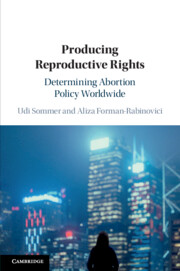Book contents
- Producing Reproductive Rights
- Producing Reproductive Rights
- Copyright page
- Dedication
- Contents
- Figures
- Tables
- Preface
- Acknowledgments
- 1 Introduction: Producing Reproductive Rights
- Part I Civil Society Sphere
- Part II State Government Sphere
- 4 The Sphere of National Governments: Dimensions of Representation
- 5 Reproductive Rights and the Nation-State: The Cases of New Zealand and Rwanda
- Part III The International Sphere
- 8 Conclusions
- References
- Index
5 - Reproductive Rights and the Nation-State: The Cases of New Zealand and Rwanda
from Part II - State Government Sphere
Published online by Cambridge University Press: 27 July 2019
- Producing Reproductive Rights
- Producing Reproductive Rights
- Copyright page
- Dedication
- Contents
- Figures
- Tables
- Preface
- Acknowledgments
- 1 Introduction: Producing Reproductive Rights
- Part I Civil Society Sphere
- Part II State Government Sphere
- 4 The Sphere of National Governments: Dimensions of Representation
- 5 Reproductive Rights and the Nation-State: The Cases of New Zealand and Rwanda
- Part III The International Sphere
- 8 Conclusions
- References
- Index
Summary
Rwanda is far from a democracy, yet proponents of gender equality may applaud the progress it has made in two specific areas. First, the Rwandan Parliament has the highest rate of female legislators in the world. Rwanda’s female majority in the legislature is a result of the political history of this country and the implementation of gender quotas. Second, in 2012, correlating with its increased rate of female representation, Rwanda liberalized its restrictive abortion policy. In New Zealand, women have had suffrage since 1893. That country has had significantly more female representatives in parliament than the global average for decades. Even with this long-standing history of female representation in a developed democracy, New Zealand has had a restrictive abortion law. Indeed, the country’s reproductive legal code has only undergone a minor change since 1977. These cases present the interplay among regime type, quotas, and female representation as determinants of abortion policy.
Keywords
- Type
- Chapter
- Information
- Producing Reproductive RightsDetermining Abortion Policy Worldwide, pp. 110 - 132Publisher: Cambridge University PressPrint publication year: 2019



